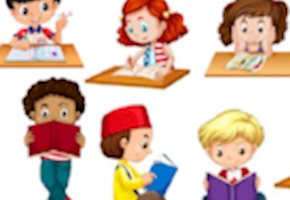Ready, Set, READ!
Understanding the Link Between Speech, Language and Multi-Sensory Reading & Writing Programs
Did you know that children who require speech therapy are at a higher risk for reading problems later on in life? Developing strong phonological awareness skills in children with speech delays proves helpful in learning to read, and even children without speech delays benefit from phonological awareness skills. In fact, children who have phonemic awareness skills are likely to read and spell more easily than children with few or none of these skills.
Phonemic awareness is the ability to notice, think about and work with the individual sounds in spoken words. Before children learn to read print, they need to be aware of how the sounds in words work. Instead, phonics is the understanding that there is a predictable relationship between phonemes and the letters that represent those sounds in written language. Children need phonemic awareness to benefit from phonics instruction, and early identification and training in auditory and oral skills is key to helping struggling readers.
There are several literacy programs for our pre-school and elementary school aged children. However, certain students have been identified as needing a more multi-sensory approach to learning how to read, write and build fluency. Orton Gillingham is an instructional approach intended primarily for use with individuals who have difficulty with reading, spelling and writing, of the sort associated with dyslexia. It is an approach that uses all of the senses – visual, auditory and kinesthetic—to help students connect language with letters and words.
Dr. Samuel T. Orton was a neuropsychiatrist and pathologist that focused on reading failure and related language processing difficulties. He brought together neuroscientific information and principles of remediation and in 1925 identified dyslexia as an educational problem. Anna Gillingham was a gifted educator and psychologist. Led by Dr. Orton, she published instructional materials from the 1930s which provided the foundation for the student instruction and teacher training in what became known as the Orton-Gillingham approach. The approach is usually associated with a one-on-one teacher-student instructional model although it is also used in small group instruction. It focuses mainly on reading, spelling and writing difficulties although it has been adapted for use with students who exhibit difficulty with mathematics.
The Orton-Gillingham Approach is direct and systematic and highly structured; it breaks down reading and spelling into smaller skills involving letter and sounds and then builds on those skills over time. There is also a strong emphasis on the how and why behind reading. By learning rules and patterns, the struggling reader learns to decode words on their own.
Since the founding of the Orton-Gillingham Approach, there have been a number of Orton-Gillingham based programs that are used to teach reading, spelling and writing to struggling students, including Wilson Reading, Barton and Lindamood Bell. The main difference is that these are programs – not approaches –and each differs somewhat in its methodology and application.
-Julia Chernova is the owner of Speech Therapy Plus LLC and is currently working on her Orton Gillingham Associate Level training through the Academy of Orton Gillingham Association of Educators and Practitioners.
Speech Therapy Plus LLC
201-509-8205 • speechtherapyplusllc.com
- 44 Godwin Ave, Suite 100 Midland Park NJ, 07432
- 11-26 Saddle River Road Fair Lawn NJ, 07410
- 5-11 Saddle River Road Fair Lawn NJ, 07410
References:
- understood.org/en/school-learning/partnering-with-childs-school/instructional-strategies/orton-gillingham-what-you-need-to-know
- homeschoolingwithdyslexia.com/comparison-orton-gillingham-reading-programs/
- ortonacademy.org/resources/what-is-the-orton-gillingham-approach/
- on-point-education.com/blog/orton-gillingham-vs-wilson-reading-systems/






Add A Comment
Thank you for your comment.
Sorry! There was a problem with your comment submission. Please try again.
Comment
Allowed HTML: <b>, <i>, <u>, <a>
Comments
Thank you for your comment.
Sorry! There was a problem with your comment submission. Please try again.
Thank you for your comment.
Sorry! There was a problem with your comment submission. Please try again.